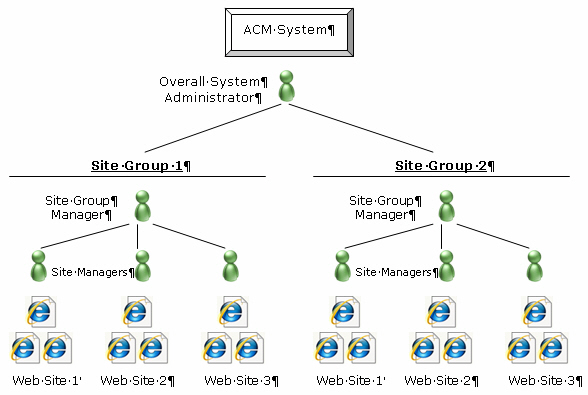![]()
![]()
NOTE: The topics in the Configuring site groups folder are primarily for the system-wide system administrators. These topics are generally not relevant for those who manage an individual site group. Be sure to read this entire topic for a complete understanding of how the Site Groups feature functions.
Site groups are best for cases where an organization wants to maintain multiple unrelated sites in separate and distinct groups. When sites are divided into groups, all data, configuration, content and assets are maintained completely separate from each other so there is no chance of confusing or mixing content.
Using site groups, a large organization such as a university, a city government, or a county, can allow different sections or departments to create their own sites. In a university this may include giving faculties, student organizations and departments their own site groups to work within. Each group can have their own Site Group Manager who can oversee the sites in that group. A top-level System Administrator retains control over all of the groups within the ACM installation.
The following diagram shows a sample of two site groups implemented in a single ACM, each site group containing 3 separate web sites..

Site groups can only be created by the System Administrator. The system administrator is the user with complete control over all of the site groups and their sites - over the entire ACM installation.
Each time the System Administrator adds site group, a special group is automatically created. Individuals added to this group function as Site Group Managers with control only over the sites within a specified site group. They do not have access to sites in other groups within the ACM.
Site Group Manager rights:
Admin rights to all sites in the site group.
Access to all tools provided to the site group manager by the system administrator, including the Export Manager so that site group managers can export their own site group sites.
Control of all user, asset and pagelet domains within their site group.
Access to all page types allowed for the site group to which they belong.
Ability to set all permissions for subsequent groups and users within the site group.
System Administrators have complete rights over all aspects of the ACM installation.
When a site group is created, a folder is automatically created in the Group Manager. The folder is named after the site group. This folder will contain all of the groups that the Site Group Manager creates. This ensures that user groups stay separate from other site groups within the ACM installation.
Example: The System Administrator creates a site group for ABC Companies. Result: the system automatically creates:
a group folder called ABC Companies Groups (in the Group Manager):

This is the folder where the Site Group Manager for ABC Companies will create all of his/her user groups.
a user group called Site Group 'ABC Companies' Managers (in the User Manager). The overall System Administrator will create user records for the Site Group Manager and put them in this group.

When site groups are enabled in the ACM, the system automatically assigns a unique site id number to the site group. All pages, assets, and other types of content and settings within the site group are tagged with the site id number to allow easy identification. This also facilitates maintaining the separateness of site group information from other site groups.
The elements that get tagged with the Site ID include the following:
Sites and Site Groups (new)
Users and Groups
Pages and Pagelets
Workflows and Workflow Folders
Digital Assets and Digital Asset Folders
Cache Policies
When the ACM is first installed, the Site Groups feature is off by default. Changes to the configuration files will turn the feature on. See Enabling site groups.